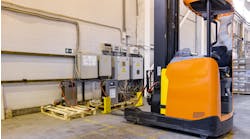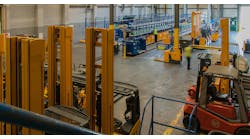Material handling is often the ugly stepchild in misguided unions.
Wherever you travel in the U.S., you'll read about mergers and acquisitions in the business section of the local newspaper. These items are as common as wedding announcements. You don't read much about the divorces in either case, however. Half of the man/wife mergers end up in divorce court. Statistics about corporate marriages are a little harder to come by.
One study I can share with you was done by Accenture. According to its survey of 100 executives at large companies in North America, South America, Europe and Asia, half (51 percent) of respondents said they consider their most recent merger/acquisition activity a success. That's sounds similar to the divorce rate I just cited, but hold on. Only 14 percent of respondents said they did not consider their mergers a success. Thirty-five percent said the jury was still out.
What makes for a good merger? Getting the details right. Details like material handling. Fewer than half (48 percent) of executives said they have confidence in their company's post-merger integration capabilities and processes. Ravi Chanmugam, a partner in Accenture's Strategy & Business Architecture practice, says these companies need to consider all aspects of the integration challenge, including core processes. That's where you come in. How is material handling managed during and after a merger or acquisition?
That's the focus of the story starting on page 20 of this issue. What I wanted to address here is how mergers and acquisitions affect you and your material handling equipment suppliers. Anyone who has been watching the material handling industry over the past decade has seen a tremendous amount of consolidation. There are now fewer but bigger vendors selling every category of material handling equipment and system. Their success is for you to judge, because, ultimately, customer service is the most vulnerable asset during mergers and acquisitions. In fact, now that opportunities to merge equipment lines have dwindled, service is driving the next urge to merge in material handling.
"For antitrust reasons, it's very hard to buy your competitors for new equipment," says Ron Giuntini, executive director of OEM Services Inc. "The real opportunity is to change your business focus. If the antitrust people in the Department of Justice are going to be a hindrance in your ability to buy companies out, then you're looking at services, and that's where every single sector is looking in acquisitions. You're starting to see independent service organizations and distributors being bought and then sold to bigger guys so that the OEMs don't have to deal with 50 dealers, but instead maybe five or six mega dealers, and using them as partners."
I asked Giuntini how this would affect you, our reader.
"It simplifies their lives," he answered. "Instead of going to an independent service guy for maintenance and someone else for service parts, they're going to the OEM for technical support. It's easier to have one contact point. Instead of being product oriented, OEMs are becoming more customer oriented."
The model is changing to service because that's where all the bucks are. OEMs know productivity is your top priority, and that's what service organizations are designed to deliver. Welcome to the postindustrial phase of the material handling industry.
Taking advantage of the industry's evolving service orientation will require some effort on your part. That's the case in any relationship. You have to work at understanding what the other party is willing to commit to. Most importantly, get the deliverables of your relationship in writing. After all, if it weren't for pre-nups, "The Donald" would be "Little Donny."


